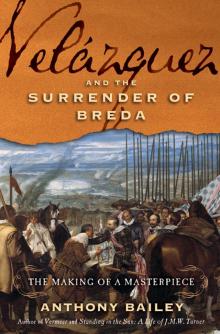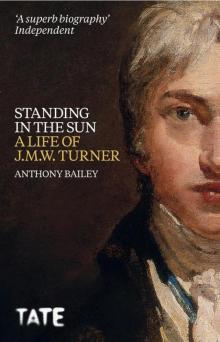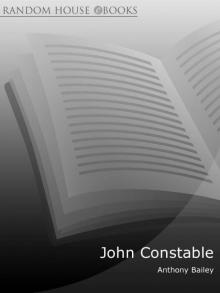- Home
- Anthony Bailey
John Constable
John Constable Read online
Contents
Cover
About the Book
About the Author
Also by Anthony Bailey
Praise
List of Illustrations
Maps
Title Page
Preface
1: Day-Spring (1776–99)
2: A Hero in Distress (1799–1802)
3: Nature’s Proper Interest (1802–10)
4: A Cure for Love (1810–13)
5: Avoiding Notice (1812–15)
6: Ready to Marry – Perhaps (1815–17)
7: Housekeeping (1817–19)
8: All but the Clouds (1820–21)
9: Skying (1821–22)
10: At the Summit of Earthly Ambitions (1822–23)
11: Trying the Sea (1824)
12: The Leaping Horse (1825–26)
13: Life Slips (1826–28)
14: Darkness Visible (1828–29)
15: Seven Children (1830–31)
16: English Landscape (1830–32)
17: Clouds Overhead (1831–32)
18: A Summer’s Morning (1833–34)
19: Fever and Fire (1834)
20: The Appearance of the Day (1833–36)
21: A Portion of England (1835–37)
22: Two Monuments (1836)
23: Engaged with the Assassin (1837)
24: The Other Side of the Grave (1837– )
Picture Section
Notes
Acknowledgements
Bibliography
Index
Copyright
About the Book
Born in 1776 in East Anglia near the river Stour, John Constable was destined for his father’s business of milling and grain-shipping. But he was obdurately opposed to this and persuaded his family he should become an artist instead. In the same determined spirit, he wooed Maria Bicknell in the teeth of opposition from her formidable grandfather, and persisted in painting landscapes at a time when history paintings and portraits were the fashion. Sometimes sharp and sarcastic, and often depressed, Constable in fact possessed a warm gift for intimate friendship. This is revealed in his letters to John Dunthorne, village handyman and housepainter, and to his best friend and patron, archdeacon John Fisher. Constable’s reputation is once again rising. This important and absorbing biography explores his life and work, and highlights the dramatic tension between the two.
About the Author
Anthony Bailey has won high praise for his books about artists: two idiosyncratic studies of Rembrandt, a much admired biography of Turner, and his masterpiece about Vermeer. He lives in Essex.
ALSO BY ANTHONY BAILEY
Fiction
Making Progress
The Mother Tongue
Major André
Nonfiction
The Inside Passage
Through the Great City
The Thousand Dollar Yacht
The Light in Holland
In the Village
A Concise History of the Low Countries
Rembrandt’s House
Acts of Union
Along the Edge of the Forest
Spring Jaunts
The Outer Banks
A Walk through Wales
The Coast of Summer
Responses to Rembrandt
Standing in the Sun – a Life of JMW Turner
A View of Delft: Vermeer Then and Now
Autobiography
America, Lost & Found
England, First & Last
‘Fascinating … thoroughly illuminating.’ Serena Davies, Daily Telegraph
‘Timely.’ John McEwen, Literary Review
‘The more one gets to know him, the more loveable Constable becomes – curmudgeonly, cantankerous, melancholy and anxiety-ridden though he was.’ Martin Gayford, Sunday Telegraph
‘Like his subject, Anthony Bailey has the great qualities of unobtrusiveness and sensitivity, letting things emerge organically rather than forcing his own imprint upon them.’ Craig Brown, Mail on Sunday
‘If, for you, the joy of reading is being absorbed into another world, this elegant and detailed life of painter John Constable, the first since 1843, will not disappoint. Anthony’s style is deceptively cool, almost unobtrusive.’ Jeffrey Taylor, Sunday Express
Illustrations
All by John Constable unless otherwise noted
Pictures in the text
1. Spring, mezzotint engraving by David Lucas after John Constable, 1830 (British Museum/Bridgeman Art Library)
2. East Bergholt House, oil on canvas, c.1810 (Tate Britain © Tate 2006)
3. Girl in a Bonnet (Maria Bicknell), undated oil on board, (Private Collection/Courtauld Institute of Art)
4. Mrs Ann Constable, oil on canvas, 1804 (Tate Britain © Tate 2006)
5. John Constable – self-portrait, pencil, 1806 (Tate Britain © Tate 2006)
6. Life drawing, female nude, black-and-white chalk, 1811 (whereabouts unknown/photo Courtauld Institute of Art)
7. Golding Constable, oil on canvas, 1815 (Tate Britain © Tate 2006)
8. Maria Bicknell, oil on canvas, 1816 (Tate Britain © Tate 2006)
9. Weymouth Bay with Jordan Hill, oil on canvas, c.1816 (National Gallery of Art, London/Bridgeman Art Library)
10. Portrait of John Fisher, oil on canvas, c.1817 (Fitzwilliam Museum, University of Cambridge/Bridgeman Art Library)
11. Elm Trees in Old Hall Park, East Bergholt, pencil with slight washes, 1817 (Victoria & Albert Museum/Bridgeman Art Library)
12. Dedham Lock and Mill, oil on canvas, 1820 (Private Collection)
13. Abram Constable, oil on canvas, 1806 (Ipswich Borough Council Museums and Galleries/Bridgeman Art Library)
14. Ann and Mary Constable, oil on canvas, 1814 (Private Collection © Agnew’s/Bridgeman Art Library)
15. Cloud Study and Verses from Bloomfield, pen and ink, 1833 (Tate Britain © Tate 2006)
16. View of Somerset House Terrace and St Paul’s, from Waterloo Bridge, oil on panel, 1819 (Yale Center for British Art, Paul Mellon Collection/Bridgeman Art Library)
17. A Mouse, oil on paper, 1824 (Constable family collection/Mellon Centre for British Art, London)
18. Rainstorm Over the Sea, oil on paper laid on canvas, c.1824–8 (Royal Academy of Arts, London/Bridgeman Art Library)
19. A Barge on the Stour, pencil and grey and sepia wash, 1827 (Victoria & Albert Museum/V&A Images)
20. Maria Constable, pencil, c.1828 (Constable family collection)
21. A Mermaid, pen, ink, and pencil, 1829 (Constable family collection)
22. John Dunthorne the Younger, undated self-portait, oil (Ipswich Borough Council Museums and Galleries)
23. Watermeadows at Salisbury, oil on canvas, 1820–29 (Victoria & Albert Museum/Bridgeman Art Library)
24. A Sea Beach, mezzotint engraving by David Lucas after John Constable, 1830 (British Museum/Bridgeman Art Library)
25. John Constable, by Daniel Maclise, pencil, c.1831 (National Portrait Gallery, London)
26. A Dog Watching a Watervole at Dedham, pencil and watercolour, 1831 (Victoria & Albert Museum/V&A Images)
27. John Charles Constable, oil on canvas on board (Private Collection/Sotheby’s Picture Library)
28. Folkestone, pencil and watercolour, 1833 (British Museum)
29. Old Sarum, watercolour, 1834 (Victoria & Albert Museum/Bridgeman Art Library)
30. Memorial to Sir Joshua Reynolds at Coleorton Hall, Leicestershire, pencil and gray wash, 1823 (Victoria & Albert Museum/Bridgeman Art Library)
31. John Constable, a bronze cast of his death mask of 1837 by Samuel Joseph (National Portrait Gallery, London)
Colour pictures
32. The Hay Wain, detail, oil on canvas, 1820–21
(National Gallery of Art, London/Bridgeman Art Library)
33. Golding Constable’s Kitchen Garden, oil on canvas, 1815 (Ipswich Borough Council Museums and Galleries)
34. Road to the Spaniards, oil on paper laid on canvas, 1822 (John G. Johnson Collection/Philadelphia Museum of Art)
35. East Bergholt Fair, oil on canvas, 1811 (Victoria & Albert Museum/V&A Images)
36. Maria Constable and two of her children, detail, oil on panel, 1820 (Tate Britain © Tate 2006)
37. View of Dedham from Gun Hill, oil on paper laid on canvas, 1810 (Tate Britain © Tate 2006)
38. Hadleigh Castle, oil on canvas, full-size sketch, 1829 (Tate Britain © Tate 2006)
39. Fen Lane, oil on canvas, unfinished, 1816 (Tate Britain © Tate 2006)
40. Study of Cumulus Clouds, oil on paper laid on canvas, 1 August 1822 (Yale Center for British Art, Paul Mellon Collection)
41. The Leaping Horse, oil on canvas, detail from full-size sketch, 1825 (Victoria & Albert Museum/Bridgeman Art Library)
42. Salisbury Cathedral from the south-west, oil on canvas, 1820 (National Gallery of Art, Washington DC/Bridgeman Art Library)
43. Brighton Beach with Colliers, oil on paper, 1824 (Victoria & Albert Museum/Bridgeman Art Library)
44. The Skylark, Dedham, oil on board, 1830 (Private Collection/Christie’s Images Ltd)
45. View of London from Hampstead, watercolour, 1833 (Victoria & Albert Museum/V&A Images)
46. A Country Lane (formerly called ‘Stoke-by-Nayland’), oil on paper laid on board, c. 1816 (Private Collection, Christie’s Images Ltd)
ANTHONY BAILEY
John Constable
A Kingdom of his Own
Preface
Constable laboured for many years with little popular success. The Royal Academy treated him haughtily as just a landscape painter, barely deserving recognition. But then the French took him up – gold medals were bestowed – and the London art world slowly opened its eyes to what he was up to. He had a select following at the time of his death and then the world came to his works and adopted them as images of an England that suddenly fitted its picture of itself (or aspiration for itself) as green and pleasant. Constable became quintessential. During the First World War, Maurice Baring wrote to Ettie Desborough about her journal, in which she had discussed the deaths of two of her sons in Flanders. ‘It sums up all that is best in England, and English things, like a Constable landscape or a speech in Shakespeare.’1 Later, there seems to have been a reaction against this at once aesthetic and patriotic admiration of Constable, as if it were all too overwhelming, swamped by nostalgia, even a bit old hat. But now one senses the tide turning again. Perhaps rightly it was in Paris in 2002 that a selection of Constable works – Le Choix de Lucian Freud – was displayed at the Grand Palais and forcefully reminded us of the revolutionary in Constable as well as what now seems traditional – indeed, reminded us of his single-minded passion for landscape at a time when painting water meadows and river banks was regarded as not quite the thing. Without him we wouldn’t have as essential parts of our beings the out-of-doors elements of an England that he saw, felt and painted.
It isn’t much of an exaggeration to say that the last biography of John Constable was published 163 years ago. In the years since, a great amount has of course been written about Constable, including several brief lifes and much art history in the shape of critical studies, scholarly monographs, and exhibition catalogues. But Charles Leslie’s Memoirs of the Life of John Constable of 1843, an astute selection of letters to and from Constable linked by a friendly commentary, has remained the text to conjure with, both charming and persuasive. However, the lacks in Leslie’s Life have also become increasingly evident: his tendency to see the best or least-troubled side of Constable; and his habit of excising anything that might strike an early-Victorian reader as coarse or indiscreet, such as getting rid of the words ‘cow-dung’ in a letter Constable wrote to the engraver David Lucas or leaving out the names of artists Leslie felt would be embarrassed by being featured in an anecdote.2 And though Leslie chose cleverly from the letters available to him, he didn’t have to hand the massive amount of correspondence which Ronald Beckett edited into half a dozen volumes in the 1960s and to which two supplementary volumes were soon added. Unfortunately also missing in Beckett’s haul are many letters to the Dunthornes, father and son, that were apparently destroyed in the 1920s.3 Nevertheless, the Constable correspondence assembled by Beckett is probably the biggest trove of documentation concerning any English artist and it has remained a vital resource and rather intractable tool for getting at John Constable.
Beckett’s work was comprehensive yet forbidding. It arranged the hundreds of letters not in one chronological sequence but in a series of volumes divided by theme: family, friends, fellow artists, letters to Leslie and so on. To find out what was happening to Constable in, say, 1827, the reader has to consult eight books and collate the findings, together with details from other sources that Beckett chose to interpolate between the letters. So Beckett’s masterwork was both boon and bother. It gave some Constable scholars, sitting with the pale green volumes (splendidly published by the Suffolk Records Society) on a shelf near their desks, the right to say no other biographical text was needed: Leslie was charming and, as for the rest, it was all in Beckett … Yes. But. In the numerous volumes of the Correspondence there are so many trees that the wood which is John Constable is hard to discern.
I have enjoyed Leslie’s Memoirs and have adopted a year-by-year framework much like his for this book. Yet, although some of the same material has gone into this account, I have all in all selected differently from the correspondence. I have – to make use of an artistic term, chiaroscuro, that Constable bandied about – given equal stress to the chiaro and the scuro, feeling that Leslie downplayed the darkness visible in Constable’s life and works, particularly in the latter part of his career. And while naturally concerned with the work which brought him, in England, a largely posthumous renown, I have devoted substantial attention to his protracted love affair with Maria Bicknell, from their first meeting when she was about twelve (and he was a grown man) to their eventual marriage and tragically abbreviated married life. I have dealt at greater length with the ups and downs of their many children and Constable’s concerns for them. He was torn between his two ambitions, between trying to perfect his life and perfect his work, though he hoped that his realm encompassed and was enriched by both his art and his family.
Spring: East Bergholt Common. Mezzotint engraving by David Lucas, after John Constable, 1830.
1. Day-Spring (1776–99)
THE LANE SLOPES gently from the village to the river, grassed ridge in the middle and wheel-ruts to either side with muddy spots and slithery patches. Gravity makes the feet go faster. On the right the trees in the lane-side hedge are thinning out. Dark furrows in the ploughed field beyond create long converging lines before vanishing together in the early morning sun. A pheasant whirrs off over a fence to a pasture where cattle are grazing. A bird’s nest can be seen; the hedge needs re-laying. The leaves have begun to turn and the last blackberries look dry and dusty. For a moment a prospect opens along the broad valley westward and the grey tower of Stratford church comes into view, marking what is still the highway – Colchester south, Ipswich north, outposts of the metropolitan world. Then Fen Lane closes in again; the shadows thicken and one feels suddenly colder.
John Constable as a boy hurrying to school would have been tempted to pause for a few seconds on the bridge, Fen Bridge, which crosses a stream coming from Stratford to join the Stour. From the bridge one can look down on dark green water, with patches of scum and out-of-focus shapes of fish below the surface, flickering from refuge to refuge. With the trees left behind he could walk fast along the raised bank to the next bridge over the Stour, the span just high enough for one of his father’s barges to get under. This is the Staunch, Bridge Meadow to its left, the Fen to the right, and ducks and a few swans
browsing as usual, with several willows growing out of the bank and old stumps, the remains of the willows’ predecessors, sticking up like blackened teeth. Across this bridge he was in the open and on the flat, skirting a water meadow. The raised edges of the valley rise on three sides, south, west, and north. A slight soft wall of clouds is forming to the south-west, and there’s the hint of a breeze which two centuries ago would have had the men at the family windmill on East Bergholt Common hauling on ropes and tackle, setting the mill in the right direction and opening up the sails. Hastening along the path, young Constable could get a bearing he didn’t need from Dedham church tower before passing a farmyard on his right, farmhouse and barn on his left, and then come between the outlying houses of Dedham village. Soon there was the inn sign of the Duke of Marlborough swinging gently on the right and Dedham church looming to the left. From the big brick building this side of the church the bell would be ringing. He would clatter up the steps, jostling with a few equally out-of-breath pupils as he dashed into the schoolroom. With luck, he would be standing at his desk as Dr Grimwood came through the door in his black scholar’s gown, as prayers were said and announcements made. Then John Constable let himself be wrapped into the school-day as into a dream, allowing the pictures in his mind of lane and fields and river to fill his head until it was time to be outside again for the walk home.
John Constable came into the world on 11 June 1776 in East Bergholt, Suffolk. The parish record of his christening on that date includes the additional, exceptional word ‘Born’ – that is, he was baptised on the actual day of his birth. The story he later heard was that he wasn’t expected to live, and the Reverend Walter Driffield had to turn out at eleven o’clock at night for a swift walk ‘over the heath’ to the Constables to make a Christian of the weakly infant.
His parents were Golding Constable, grain merchant, mill owner and farmer of ninety-three acres, and Ann Watts Constable, daughter of a London barrel-making manufacturer. Golding Constable’s childless Uncle Abram, who had interests in Suffolk and London, had named him as the heir to much of his estate. As for Ann, provided with a good dowry, she married Golding in 1767, when she was eighteen. In 1776 the Constables already had two daughters and a son, all born in the mill house by the river at Flatford. John was the first to be born in their grand new village residence, East Bergholt House, which had four large rooms and some smaller on each of the three floors, as well as stables and a coach house. Despite his uncertain first hours, Constable was soon a healthy, thriving child. Golding Constable could begin to hope that he had a capable heir as miller and merchant. His daughters Ann and Martha were eight and seven years older than John, and their brother Golding, born in 1774, was disappointingly slow – epilepsy was mentioned.

 Velázquez and the Surrender of Breda
Velázquez and the Surrender of Breda J.M.W. Turner
J.M.W. Turner John Constable
John Constable